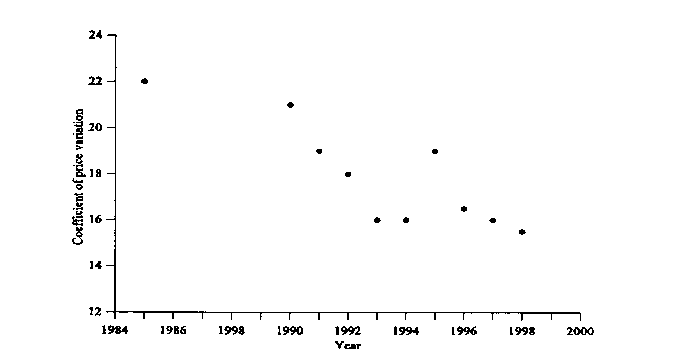The illustrated remarkable increase of trade intensities between the Member
States has at the macroeconomic level strengthened the spillovers of aggregate
demand. At the microeconomic level the increased mobility of goods and
services tends to equalise the individual prices for goods and services.
However, the effect of trade liberalisation on price differences varies a great
deal from one item of goods to the other. More precisely, the decrease in price
dispersion depends on the size of transport and other trade costs after the
elimination of tariffs and quotas. For those tradeables, where trade costs are low
after liberalisation, the price dispersion is similarly low. For non-tradeables, on
the other hand, trade costs after liberalisation are significant and, as a
consequence, the markets are segmented. In this case, the formation of the
customs union and the Internal Market has only reduced price dispersion to a
limited degree. The distinction between tradeables and non-tradeables applies to
both goods and services. Figure 3 illustrates the development in the price
dispersion between the Member States for private final consumption from 1985
to 1998. The figure show a clear decrease of price dispersion during the years
where The Internal Market was established as price dispersion was reduced
from about 22-23% in 1985 to about 16% in 1998.1
Figure 3. Price dispersion among Member States, 1985-98

Note: The figure shows the coefficient of variance for prices of consumer goods
between Member States. The coefficient of variance is defined by the spread
divided by the mean in the statistical distribution of prices for consumer
goods. Prices include taxes (excise duties and value-added tax).
Source: EU Commission (2000).
1 Also to the extent that taxes in the future are becoming more harmonised within the Union this
should further narrow down the spread in prices.
14
More intriguing information
1. Can a Robot Hear Music? Can a Robot Dance? Can a Robot Tell What it Knows or Intends to Do? Can it Feel Pride or Shame in Company?2. The name is absent
3. The ultimate determinants of central bank independence
4. Accurate, fast and stable denoising source separation algorithms
5. Competition In or For the Field: Which is Better
6. The name is absent
7. Gender and headship in the twenty-first century
8. The name is absent
9. The name is absent
10. fMRI Investigation of Cortical and Subcortical Networks in the Learning of Abstract and Effector-Specific Representations of Motor Sequences